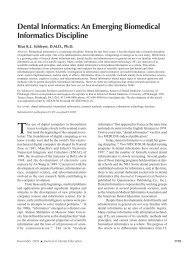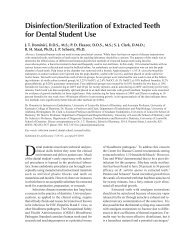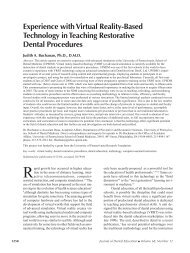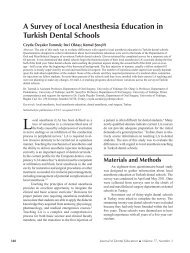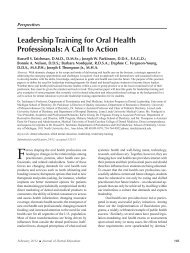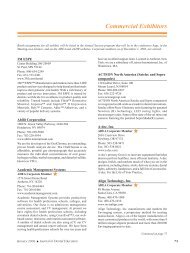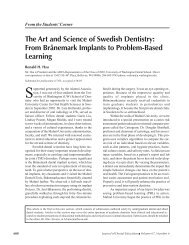Physical and chemical aspects of saliva as indicat... - ResearchGate
Physical and chemical aspects of saliva as indicat... - ResearchGate
Physical and chemical aspects of saliva as indicat... - ResearchGate
You also want an ePaper? Increase the reach of your titles
YUMPU automatically turns print PDFs into web optimized ePapers that Google loves.
vivo is very small. This consideration is b<strong>as</strong>ed on the<br />
fact that the <strong>saliva</strong>ry system exhibits several levels <strong>of</strong><br />
redundancies (Figure 1). At the morphological level<br />
there is redundancy by the presence <strong>of</strong> more than one<br />
major <strong>saliva</strong>ry gl<strong>and</strong> <strong>and</strong> that the major gl<strong>and</strong>s occur in<br />
pairs. Some <strong>saliva</strong>ry constituents are specific for one<br />
type <strong>of</strong> gl<strong>and</strong>; others occur in more than one type <strong>of</strong><br />
gl<strong>and</strong>ular secretion. On the molecular level there is functional<br />
redundancy since different <strong>saliva</strong>ry proteins can<br />
display similar functional characteristics. Also there is<br />
molecular redundancy with respect to individual <strong>saliva</strong>ry<br />
proteins, which h<strong>as</strong> an evolutionary b<strong>as</strong>is. Most<br />
<strong>saliva</strong>ry proteins have evolved into families <strong>of</strong> polymorphic<br />
forms. Within each <strong>of</strong> such a protein family,<br />
the individual members differ structurally in minor ways<br />
but exhibit almost the same functional characteristics.<br />
It h<strong>as</strong> become clear that these multiple levels <strong>of</strong> redundancies<br />
in the <strong>saliva</strong>ry system introduce great difficulties<br />
for the identification <strong>of</strong> specific <strong>saliva</strong>ry parameters<br />
<strong>as</strong> dise<strong>as</strong>e risk factors. There is little doubt,<br />
however, that each <strong>of</strong> the <strong>saliva</strong>ry constituents makes a<br />
contribution to the overall <strong>saliva</strong>ry functional capacity.<br />
In conclusion, normal <strong>saliva</strong>ry output, <strong>as</strong> quantified<br />
by flow rate, is an extremely important intrinsic<br />
host factor providing protection against caries, <strong>and</strong> the<br />
evidence demonstrating that pathologically diminished<br />
flow rate is a significant risk factor for caries development<br />
is quite strong (Table 2). Some studies <strong>indicat</strong>e<br />
that <strong>saliva</strong>ry low buffering capacity, low calcium <strong>and</strong><br />
phosphate, <strong>and</strong> low specific sIgA show a less pronounced<br />
link to incre<strong>as</strong>ed caries. No <strong>as</strong>sociation with<br />
caries risk w<strong>as</strong> found for <strong>saliva</strong>ry pH, other electrolytes<br />
or small molecules, total sIgA, IgG, IgM, <strong>and</strong> other<br />
<strong>saliva</strong>ry proteins, including those <strong>of</strong> the innate host defense<br />
system. It is possible that this lack <strong>of</strong> correlation<br />
is due to the multiple levels <strong>of</strong> structure-function redundancies<br />
found in <strong>saliva</strong>.<br />
Acknowledgments<br />
This research w<strong>as</strong> supported in part by NIH/<br />
NIDCR Grants DE05672 <strong>and</strong> DE07268. The authors<br />
express their gratitude to Dr. Ibtisam Al-H<strong>as</strong>himi,<br />
Baylor College <strong>of</strong> Dentistry, for critically reviewing the<br />
evidence report. The following individuals from the<br />
Boston University <strong>saliva</strong>ry research group are also<br />
thanked for their help: Drs. Bianca Flora, Heloisa<br />
Gusman, Peter Ksenyuk, Ji Li, Giacomo Ori, Sean<br />
Rayment, Robert Troxler, Yuan Yao, Aidi Yin, Mr. Joseph<br />
Keen <strong>and</strong> Ms. Kathrin Tschannen. The <strong>as</strong>sistance<br />
<strong>of</strong> Ms. Mary McKeon <strong>of</strong> the Boston University Alumni<br />
Medical Library is also acknowledged. Special appreciation<br />
is given to Ms. Patricia F. Anderson, University<br />
<strong>of</strong> Michigan, for invaluable <strong>as</strong>sistance with the library<br />
searches that made this work possible.<br />
REFERENCES<br />
1. Almstahl A, Kroneld U, Tarkowski A, Wikstrom M. Oral<br />
microbial flora in Sjögren’s syndrome. J Rheumatol<br />
1999;26:110-4.<br />
2. Dahll<strong>of</strong> G, Ussisoo-Jo<strong>and</strong>i R, Ideberg M, Modeer T. Caries,<br />
gingivitis, <strong>and</strong> dental abnormalities in preschool children<br />
with cleft lip <strong>and</strong>/or palate. Cleft Palate J<br />
1989;26:233-7; discussion 237-8.<br />
3. Furh<strong>of</strong>f AK, et al. A multidisciplinary clinical study <strong>of</strong><br />
patients suffering from illness <strong>as</strong>sociated with rele<strong>as</strong>e <strong>of</strong><br />
mercury from dental restorations: medical <strong>and</strong> odontological<br />
<strong><strong>as</strong>pects</strong> [see comments]. Sc<strong>and</strong> J Primary Health<br />
Care 1998;16:247-52.<br />
4. Guivante-Nabet C, Berenholc C, Berdal A. Caries activity<br />
<strong>and</strong> <strong>as</strong>sociated risk factors in elderly hospitalised population—15-months<br />
follow-up in French institutions.<br />
Gerodontol 1999;16:47-58.<br />
5. Holbrook WP. Dental caries <strong>and</strong> cariogenic factors in preschool<br />
urban Icel<strong>and</strong>ic children. Caries Res 1993;27:431-<br />
7.<br />
6. Holbrook WP, de Soet JJ, de Graaff J. Prediction <strong>of</strong> dental<br />
caries in pre-school children. Caries Res 1993;27:424-<br />
30.<br />
7. Johansson I, Saellstrom AK, Rajan BP, Parameswaran A.<br />
Salivary flow <strong>and</strong> dental caries in Indian children suffering<br />
from chronic malnutrition. Caries Res 1992;26:38-<br />
43.<br />
8. Najera MP, al-H<strong>as</strong>himi I, Plemons JM, Rivera-Hidalgo F,<br />
Rees TD, Haghighat N, Wright JM. Prevalence <strong>of</strong> periodontal<br />
dise<strong>as</strong>e in patients with Sjögren’s syndrome. Oral<br />
Surg Oral Med Oral Pathol Oral Radiol Endod<br />
1997;83:453-7.<br />
9. Ohrn R, Enzell K, Angmar-Mansson B. Oral status <strong>of</strong> 81<br />
subjects with eating disorders. Eur J Oral Sci<br />
1999;107:157-63.<br />
10. Pedersen AM, Reibel J, Nordgarden H, Bergem HO,<br />
Jensen JL, Naunt<strong>of</strong>te B. Primary Sjögren’s syndrome:<br />
<strong>saliva</strong>ry gl<strong>and</strong> function <strong>and</strong> clinical oral findings. Oral<br />
Dis 1999;5:128-38.<br />
11. Ravald N, List T. Caries <strong>and</strong> periodontal conditions in<br />
patients with primary Sjögren’s syndrome. Swed Dent J<br />
1998;22:97-103.<br />
12. Ryberg M, Moller C, Ericson T. Saliva composition <strong>and</strong><br />
caries development in <strong>as</strong>thmatic patients treated with beta<br />
2-adrenoceptor agonists: a 4-year follow-up study. Sc<strong>and</strong><br />
J Dent Res 1991;99:212-8.<br />
13. Stiefel DJ, Truelove EL, Menard TW, Anderson VK, Doyle<br />
PE, M<strong>and</strong>el LS. A comparison <strong>of</strong> the oral health <strong>of</strong> persons<br />
with <strong>and</strong> without chronic mental illness in community<br />
settings. Spec Care Dent 1990;10:6-12.<br />
14. Stiefel DJ, Truelove EL, Persson RS, Chin MM, M<strong>and</strong>el<br />
LS. A comparison <strong>of</strong> oral health in spinal cord injury <strong>and</strong><br />
other disability groups. Spec Care Dent 1993;13:229-35.<br />
15. Tukia-Kulmala H, Tenovuo J. Intra- <strong>and</strong> inter-individual<br />
variation in <strong>saliva</strong>ry flow rate, buffer effect, lactobacilli,<br />
October 2001 ■ Journal <strong>of</strong> Dental Education 1059



